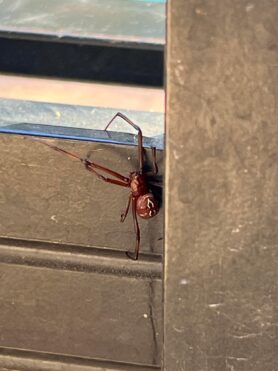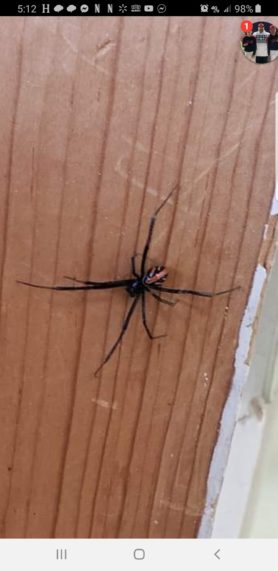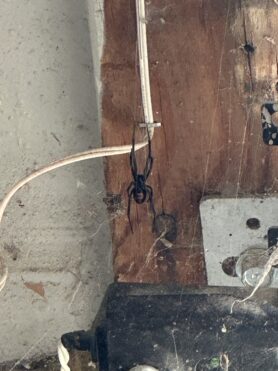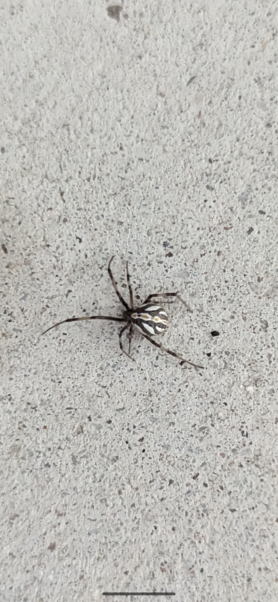
Comments & ID Thoughts
I have no clue what type of spider this could be... maybe a triangularcombweb but the abdomen look to be a little different. It has some web in the mailbox where it lives with another black and yellow huge spider. That spider picture is coming soon. What type of spider do you think it might be?
- Submitted by:

- Submitted: Feb 18, 2020
- Photographed: Feb 14, 2020
- Spider: Latrodectus hesperus (Western Black Widow)
- Location: Modesto/Waterford , California, United States
- Spotted Outdoors: Man-made structure (building wall, fences, etc.)
- Found in web?: Yes
- Attributes: Lateral




Hi there this could be a Neoscona arabesca
(Arabesque Orb-weaver) :3
I’m pretty sure it is a Brown Widow, Latrodectus geometricus. The pattern colors change with maturity at different rates depending on gender. So, yes it is a Combfoot spider in family Theridiidae. The venom isn’t as dangerous as a Black Widow, but it is rather dangerous. You might want to gently remove it from your mailbox without pressing skin against it. They bite in response to pressure against their bodies or feeling trapped. The egg sacs look like white spiky balls. https://bugguide.net/node/view/996215/bgimage
There is another bigger spider in the back of the mailbox. It bigger with the same design on the abdomen but the overall color to that one is darker than the caramel spider we are talking about… could brown windows turn black with white stripe down and two on the sides? I’ll upload pictures of what I got I’ll try to get more and possibly move them. I super appreciate you guys responding!
I think you right. Which is cool lol it’s a beautiful spider!
I would cry!! My favorite type of spiders are the orb weavers! 😀
Orbweavers are actually easier to find than Black Widows in most of the World. 🙂 I find them by using a dim LED flashlight after dusk. The orb webs are easy to find. in the flashlight glow. It works in shaded places during the day for some species too. They tend to be in places where you know bigger wildlife species are. Deer, skunks, rabbits, snakes and other animals that hide in brushy dense areas during the day, in my experience, are where the orbweavers are.
I’m in California so I would find any but its worth a look! Thank you! I want to find an orb weaver to keep as a pet!
There are plenty of Orbweaver species in California, they should be easier to find there than New Hampshire. If you click on California in red type in your location or in the menu at the upper right, you’ll see the species that have been submitted to our site. You have spiders on genera Eriophora, Araneus, Trichonephila, Argiope, and more. The latter two are really big spiders. The females live roughly Autumn to Autumn, the males don’t usually live as long. They are easiest to find in late summer/early autumn. The females can be kept as pets in the wild. They… Read more »
God I want to be your friend lol no one I know really likes spider like I lol you’re full of information that i find incredibly interesting and I appreciate you responding to my post! I’ll take a look at the map(I’m super new so I have no idea about the functions) I’ll take your instructions to heart and once late summer early autumn comes i’ll go out exploring! Oh man she must have been a beauty! A badass btch to eat those wasps lol their webs are so awesome too so strong they are the best spiders in my… Read more »
Welcome Friend! A lot of us find that it is hard to find people in the physical world who understand our obsessions. There is a good side to that, I can escape people I don’t want to talk to by whipping out my phone to show my spider photos. Nobody follows me into briar thickets full of spiders and snakes, except kids and other nerdy women. I haven’t had a pet spider indoors yet, but a neighbor just gave me a fish tank. I have a bunch of birdhouses outside that spiders live in when birds don’t. I found a… Read more »
Latrodectus hesperus, Western Black Widow
Do you know if it’s a brown widow and do they turn black with each molt? Ps thank you!
No, this is a Western Black Widow, Latrodectus hesperus. It’s likely a male and will not turn black. The females can turn black. An easy way to tell them apart … Brown Widows (Latrodectus geometricus) have a more distinct line of spots down the abdomen, the spots fuse together into a line on the Western Black Widow. https://bugguide.net/node/view/1505025/bgimage